Cutting Football Best Way to Save Others, Stone Says : Titans: Dropping sport trims budget by 25% and saves remaining programs, council member says. Coach Murphy agrees.
Dropping Cal State Fullerton’s football program is the only viable option for dealing with massive budget cuts, an athletics council member said Sunday, and Titan Coach Gene Murphy said he understood why the advisory board made its recommendation to university President Dr. Milton A. Gordon.
“I’m not bitter, I’m just sad for a lot of people,” said Murphy, who recently completed his 11th season at Fullerton. “I understand a lot of things about budgets. We’ve been cut back drastically in the last three or four years.”
With the university facing $14 million in cuts in the coming school year, the athletic department was told last week that it must trim $500,000 to $650,000 from its 1991-92 budget.
To spread those cuts proportionally over all Titan teams would greatly damage each program, and it would mean cutting the $1.3 million football budget by $250,000 to $300,000, said Barbara Stone, who chairs the athletics council.
“So instead of destroying every team, we took one,” Stone said. “We had the worst-ranked Division I-A football team in the country last year and we’d be cutting the budget by 25%. Tell me what they would do next year?
“We figured we would destroy football anyway, and damage the other sports, so we came up with the recommendation. It was extraordinarily unpleasant.”
Gordon said he will consult with city officials, school administrators, faculty members and athletic department personnel this week before making a final decision on the recommendation.
Asked if there was any chance football could be saved, Stone said, “Let’s put it this way: I’m glad I’m not the president. I would have never voted for this recommendation if I thought there was an alternative.”
Murphy said he was told Thursday night there would be no money for scholarships next season, so he canceled weekend recruiting trips, released six community college players from letters of intent and told other recruits to pursue other schools. Current players said Murphy informed them football was being dropped.
Gordon said he thought Murphy’s actions were premature because the president hadn’t acted on the recommendation, but Murphy didn’t think he had an alternative.
“I’m not going to let kids hang so I had to cut them loose,” Murphy said. “I told (the current players) there was a severe budget crunch and there was a good possibility the sport was gone. I wanted them to hear it from me before they read it in the paper.”
What frustrates Murphy most is that he had oral commitments from 18 players and considered this one of his best recruiting classes. Many of the recruits were expected to help the Titans rebound from a 1-11 season, Fullerton’s worst in its 21-year history.
“I don’t think we’ve ever had that caliber of player coming into the program,” Murphy said. “The guys did a super job recruiting.”
The consequence for the assistant coaches, if the program is dropped, is they lose their jobs. However, Murphy said his six full-time assistants have received contract extensions that run until the end of June. Murphy has two years remaining on his contract and could be re-assigned to another position in the athletic department if he elects to stay.
If football is dropped, Gordon said he hopes to revive the program in a few years. The $10.2-million Titan Sports Complex, which will include a 10,000-seat football stadium, is under construction on campus and is expected to be completed in 1992.
To bring back Division I-A football would involve huge start-up costs, primarily because of the number of scholarships and coaches required at that level.
But Stone says the future of Fullerton football is at the proposed Division I-AAA level, on which schools that are Division I in all other sports could field nonscholarship football teams.
The Division I-AAA proposal won’t be voted on until the 1992 NCAA convention and, if passed, likely would take an additional two or three years to be put in place.
“The chances of coming back in a few years are better than people think,” Stone said. “We wouldn’t have kids on scholarship, we have the basic equipment and a place to play, so we’ve already invested in start-up costs.”
But Division I-AAA football would basically be Division III football with a Division I label. This doesn’t exactly excite Murphy, but he wouldn’t rule out the possibility of remaining at Fullerton to coach at such a level.
“It depends if I have a job or not,” Murphy said. “I can’t be too fussy about it now.”
More to Read
Go beyond the scoreboard
Get the latest on L.A.'s teams in the daily Sports Report newsletter.
You may occasionally receive promotional content from the Los Angeles Times.







